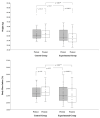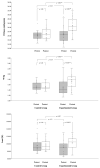Effects of 10-Week Online Moderate- to High-Intensity Interval Training on Body Composition, and Aerobic and Anaerobic Performance during the COVID-19 Lockdown
- PMID: 38200944
- PMCID: PMC10778575
- DOI: 10.3390/healthcare12010037
Effects of 10-Week Online Moderate- to High-Intensity Interval Training on Body Composition, and Aerobic and Anaerobic Performance during the COVID-19 Lockdown
Abstract
The present study aimed to investigate the effects of a 10-week online high-intensity interval training (HIIT) program on body composition and aerobic and aerobic performance in physically sedentary women. A parallel, two-group, longitudinal (pre, post) design was used with physical tests performed before (preintervention) and after (postintervention) the 10-week intervention period. A total of forty-eight healthy and physically sedentary women (defined as an individual who lacks regular exercise or a structured fitness routine) were recruited to participate in this study. The participants were distributed in two groups: the experimental group (EG) with 24 women (mean ± SD: age 21.21 ± 2.15 years; weight: 61.16 ± 8.94 kg; height: 163.96 ± 4.87 cm; body mass index (BMI): 22.69 ± 2.49 kg/m2) and the control group (CG) with another 24 women (mean ± SD: age 20.50 ± 1.29 years; weight: 62.0 ± 6.65 kg; height: 163.92 ± 4.89 cm; body mass index: 23.04 ± 1.74 kg/m2). The EG performed an online HIIT program for 10 weeks, while the CG continued with their daily life routines. The repeated measures ANCOVA indicated a significant effect in the within-group analysis for weight (p = 0.001; d = -0.96) and for BMI (p = 0.001; d = 0.24), with a significant decrease in the experimental group (EG). The control group (CG) did not show any significant decrease in either body weight or BMI. Regarding the maximal oxygen uptake (VO2 max) values, the EG exhibited a significant improvement (p = 0.001; d = -1.07), whereas the CG did not demonstrate a significant improvement (p = 0.08; d = -0.37). The EG's power output (W) (p = 0.001; d = -0.50) and power output standardized by body weight (W/kg) (p = 0.001; d = -0.96) were significantly improved. The CG did not show a significant improvement in either power output (W/kg) or power output. Lastly, the within-group analysis with load revealed that the EG significantly improved (p = 0.001; d = -0.50), while CG did not show a significant improvement in load (p = 0.10.; d = -0.10). The present study showed that 10 weeks of HIIT in an online environment during the COVID-19 lockdown significantly improved maximum oxygen consumption and caused weight loss and a significant decrease in body mass index in physically sedentary women. These results suggest that HIIT may be used as a time-efficient strategy to improve body composition and cardio-respiratory fitness in sedentary women.
Keywords: anthropometric; interval training; performance; sedentary; women.
Conflict of interest statement
The authors declare no conflict of interest.
Figures


Similar articles
-
A Comparative Study of Health Efficacy Indicators in Subjects with T2DM Applying Power Cycling to 12 Weeks of Low-Volume High-Intensity Interval Training and Moderate-Intensity Continuous Training.J Diabetes Res. 2022 Jan 13;2022:9273830. doi: 10.1155/2022/9273830. eCollection 2022. J Diabetes Res. 2022. PMID: 35071605 Free PMC article. Clinical Trial.
-
Effect of High-Intensity Interval Training on Body Composition, Cardiorespiratory Fitness, Blood Pressure, and Substrate Utilization During Exercise Among Prehypertensive and Hypertensive Patients With Excessive Adiposity.Front Physiol. 2020 Oct 19;11:558910. doi: 10.3389/fphys.2020.558910. eCollection 2020. Front Physiol. 2020. PMID: 33192554 Free PMC article.
-
Two Weeks of High-Intensity Interval Training in Combination With a Non-thermal Diffuse Ultrasound Device Improves Lipid Profile and Reduces Body Fat Percentage in Overweight Women.Front Physiol. 2019 Oct 22;10:1307. doi: 10.3389/fphys.2019.01307. eCollection 2019. Front Physiol. 2019. PMID: 31695621 Free PMC article.
-
Effects of High-Intensity Interval Training in Combat Sports: A Systematic Review with Meta-Analysis.J Strength Cond Res. 2020 Mar;34(3):888-900. doi: 10.1519/JSC.0000000000003255. J Strength Cond Res. 2020. PMID: 31904713
-
Effect of High-Intensity Interval Training Versus Sprint Interval Training on Time-Trial Performance: A Systematic Review and Meta-analysis.Sports Med. 2020 Jun;50(6):1145-1161. doi: 10.1007/s40279-020-01264-1. Sports Med. 2020. PMID: 32034701
Cited by
-
Deep phenotyping of patients with MASLD upon high-intensity interval training.JHEP Rep. 2024 Dec 16;7(3):101289. doi: 10.1016/j.jhepr.2024.101289. eCollection 2025 Mar. JHEP Rep. 2024. PMID: 40051412 Free PMC article.
References
-
- Caroppo E., Mazza M., Sannella A., Marano G., Avallone C., Claro A.E., Janiri D., Moccia L., Janiri L., Sani G. Will Nothing Be the Same Again? Changes in Lifestyle during COVID-19 Pandemic and Consequences on Mental Health. Int. J. Environ. Res. Public Health. 2021;18:8433. doi: 10.3390/ijerph18168433. - DOI - PMC - PubMed
-
- Thompson W.R. Worldwide survey of fitness trends for 2019. ACSM’s Health Fit. J. 2018;22:10–17. doi: 10.1249/FIT.0000000000000438. - DOI
LinkOut - more resources
Full Text Sources

